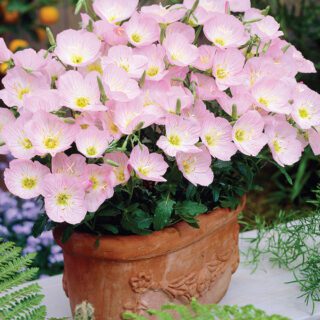How to Grow Purple Loosestrife from Seeds
Purple Loosestrife (Lythrum salicaria) is a beautiful wildflower, commonly found along the edges of rivers, ponds, lakes, and other bodies of water. Its tall, rose-purple flowering spikes make it an ideal choice for adding vertical interest to garden ponds or water features. Growing up to 150 cm (5 feet) tall, this perennial is a magnet for pollinators like bees and butterflies. Native to much of Europe, Purple Loosestrife thrives in wet, boggy conditions but is versatile enough to grow in well-drained garden soil, making it a great addition to borders, beds, and wildlife gardens.
When and Where to Sow Purple Loosestrife Seeds
- Outdoor Sowing: Sow seeds directly outdoors in late spring to early summer (April to June), when the soil is moist and the risk of frost has passed. Choose a location near a pond, stream, or other water feature where the soil remains consistently damp.
- Indoor Sowing: For an early start, sow seeds indoors in pots or seed trays from March onwards. Transplant seedlings outdoors once they have grown large enough to handle and the risk of frost has passed.
Ideal Growing Conditions for Purple Loosestrife
- Soil Requirements: Purple Loosestrife thrives in consistently moist to wet soil. It grows particularly well in boggy areas, near the edges of ponds, or in areas with poor drainage. If growing in garden soil, ensure it remains damp for optimal growth.
- Sunlight: This wildflower prefers full sun to partial shade. Choose a sunny location that receives at least 6 hours of sunlight per day for the best flower display.
- Temperature: Ideal germination temperatures are between 15-20°C (59-68°F). Once established, Purple Loosestrife is hardy and tolerant of a wide range of UK temperatures.
How to Sow Purple Loosestrife Seeds Indoors
- Sowing in Pots or Trays: Fill seed trays or small pots with a moist, well-drained seed compost. Sow the seeds on the surface of the compost and press them gently into the soil. Purple Loosestrife seeds need light to germinate, so do not cover them with compost.
- Germination Conditions: Place the pots or trays in a warm, sunny location, such as a windowsill or greenhouse. Keep the compost consistently moist but not waterlogged. Covering the pots with clear plastic or polythene can help retain moisture and improve germination conditions.
- Watering: Ensure the compost remains damp throughout the germination period. Germination typically takes 10-21 days, depending on temperature and moisture levels.
- Transplanting Seedlings: Once the seedlings have grown to about 7-10 cm (3-4 inches) tall and are strong enough to handle, transplant them into larger pots or directly into the garden. If planting near water, wait until the plants have reached a height of 30 cm (12 inches) before submerging them in shallow water or placing them on a pond shelf.
How to Sow Purple Loosestrife Seeds Outdoors
- Preparing the Site: Choose a damp area near water, such as a pond edge or bog garden. Prepare the soil by removing any weeds and working it to a fine tilth. If planting directly into a pond, use a pond shelf or waterlogged soil for the best results.
- Sowing Depth and Spacing: Sow the seeds directly on the surface of the soil, lightly pressing them down. Do not cover the seeds, as they require light to germinate. Space the seeds or seedlings 30-45 cm (12-18 inches) apart to allow room for the plants to spread.
- Watering: Water the area thoroughly after sowing to ensure the soil remains damp. Keep the soil consistently moist throughout the germination period and as the seedlings establish.
- Germination: Germination may take up to 2-4 weeks, depending on outdoor conditions. Ensure the area remains moist and protected from pests like slugs and snails, which can damage young seedlings.
Caring for Purple Loosestrife Plants
- Watering: Keep the soil consistently moist, especially during dry periods. Purple Loosestrife thrives in damp conditions, so ensure the soil or growing medium does not dry out.
- Feeding: Purple Loosestrife generally does not require additional fertiliser. However, if grown in poor soil, a light application of a balanced, slow-release fertiliser can encourage healthy growth.
- Pruning: Deadhead spent blooms to encourage continuous flowering throughout the summer. In autumn, cut back the plants to ground level to encourage fresh growth in the following spring.
- Overwintering: Purple Loosestrife is a hardy perennial that will die back in winter and regrow in spring. Mulching around the base of the plants in late autumn can help protect the roots during colder months.
Using Purple Loosestrife in the Garden
- Pond Edges and Water Features: Purple Loosestrife is perfect for planting along the edges of ponds, lakes, or streams. Its tall, striking flowers create a beautiful display and help soften the transition between water and land.
- Wildlife Gardens: As a magnet for bees, butterflies, and other pollinators, Purple Loosestrife is ideal for wildlife gardens and naturalised areas. It provides nectar and pollen for beneficial insects throughout the summer.
- Mixed Borders and Beds: Purple Loosestrife can also be grown in garden borders and beds, where its tall, spiky flowers add height and colour. It pairs well with other moisture-loving plants like irises and hostas.
Common Issues and Tips for Growing Purple Loosestrife
- Pests: Slugs and snails may damage young seedlings. Protect plants with organic slug pellets, copper tape, or other slug deterrents, particularly during the early growth stages.
- Self-Seeding: Purple Loosestrife can self-seed readily if left to its own devices. If you wish to control its spread, deadhead the flowers before they set seed.
- Overwatering: While Purple Loosestrife loves damp conditions, ensure the soil is well-drained to prevent waterlogging. Waterlogged soil can lead to root rot, particularly if the plants are grown in containers.
Common Questions About Growing Purple Loosestrife
- Can Purple Loosestrife be grown in containers? Yes, Purple Loosestrife can be grown in containers as long as the soil is kept consistently moist. Choose a large container with good drainage and place it in a sunny spot.
- How long does Purple Loosestrife flower for? Purple Loosestrife blooms from mid-summer to early autumn. Regular deadheading can help extend the flowering period.
- Is Purple Loosestrife good for pollinators? Absolutely! Purple Loosestrife is a great plant for attracting bees, butterflies, and other pollinators, making it a valuable addition to wildlife-friendly gardens.
By following these steps, you can successfully grow Purple Loosestrife in your garden, whether near a pond or as part of a mixed border. With its tall, vibrant blooms and ability to attract wildlife, this versatile plant is a stunning and low-maintenance addition to any outdoor space.



















